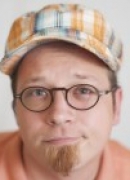
Michael Pinchera
Senior Editor, Meeting Professionals International
Michael Pinchera is an award-winning writer and editor covering business, meetings and events and pop culture topics since 1997.
For three days at the tail end of February, I joined a couple of dozen meeting professionals, all either from Caesars Entertainment or invited by that organization in a window-filled room beside the High Roller in Las Vegas to learn how to plan with the #EventCanvas.
I walked in curious and skeptical, my base approach to most things. Not a fan of boring social ice breakers, this gathering with, primarily, strangers proved early on to be different, with compelling approaches to inter-personal communication and brainstorming. I drew a cartoon character I created as a child to represent me. This segued into a brief, unexpectedly personal discussion about the character’s origins and suddenly these strangers knew me better than many people I see daily.
Once I realized how significantly different this introduction was compared to, well, every instance of professional education in which I’ve participated, my natural skeptic shell began to soften. I still don’t totally understand how these Dutch guys are going to use some sort of formula and graphical charts to suss out the best and most appropriate event goals, I thought: but benefit of the doubt was starting to be supplanted by successful first-person experiences.
The ‘Dutch guys’ referenced are Roel Frissen and Ruud Janssen, creators of the Event Canvas methodology and this Event Design program the goal of which, for most, is to earn the CED designation.
Introductions aside, we learn the bones of the process, marveling as Frissen and Janssen transform a large paper scroll taped to the floor into a visual event roadmap. Each step for each of the various stakeholders is right there, complete with directional arrows, illustrations representing actions, locations and desired behavioral changes and more. Then we boarded a cabin on the High Roller for each participant to pitch an event real or hypothetical. Two were selected and would be the armature around which our work for the coming days would revolve.
The very full Day 1 came to a close around 5 p.m., yet there was still some uncertainty in my mind about how this whole thing could work.
“Trust the process” Frissen told me as we chatted while packing up for the day.
Rather than become overwhelmed with questions and lingering elements I didn’t yet thoroughly understand, I metaphorically threw my arms in the air and resigned to the fact that in the morning, I’d be closer to my goal of complete understanding.
Day 2 was incredibly busy in smaller groups. Having selected the two events to design, the room was split into two groups, one for each event and then those groups were further split into smaller factions, each tasked with plotting the event experience for specific stakeholders.
At one point, we were all instructed to split up into pairs to prototype ideas. I felt confident about the activity until speaking with my partner, she understood our task to be something different. Seeking clarity from Frissen, my partner seemed reassured; I was now confused. The task was to just last a few minutes, so I again metaphorically threw my arms in the air and we got down to business. As our group reconvened, it sounded as though each pair had a slightly different understanding of what we were tasked with achieving prior to going over our mental output together. Before my mind completed the thought, Oh crap, we wasted those prototyping minutes, a connection was made. All the parts were somehow coming together. One pair discussed a specific event component and their thoughts about it suddenly the misdirected prototyping I’d done fit it! Yes, I got excited because the seemingly disparate pieces were coming together. Quickly. This all seemed much more than serendipity. When Frissen walked by to ask how we were doing, I surely acted like a school kid who finally understood a pesky algebra formula.
The level of detail can be overwhelming if you focus on the vast expanse of everything needed to structure a successful event and, of course, the prospect of mapping it out in two days. Dedicating set amounts of time to focus on each of the countless tasks involved in planning an event, and then moving on in an orderly fashion to the next task, indeed seemed to resolve the anxiety of too much. This process certainly saves time, as well as stress, in the long run, but don’t get me wrong, this was a long, mentally exhausting day. Longer than Day 1. The progress was evidenced by the oversized Post-it-covered sheets labelled Empathy Map and Prototyping Arena covering the walls and windows in the meeting room, hallway and outdoor patio.
Participant chat over dinner at Mr. Chow revealed the need for some cognitive rest prior to the upcoming, concluding day. I was becoming slap happy.
After some coffee/tea, the activity began swiftly on Day 3, each group picking up right where it had left off. Day by day, more ah-ha moments manifested, sometimes seemingly out of the blue. More clarity and more exhaustion. By that afternoon, we’d created thorough Event Canvases for two very different events, including video walkthroughs shared on WhatsApp to explain the desired and anticipated event experience for each of the stakeholders. How would you like the behavior of so-and-so to change once the event is over, and how will you accomplish that? Well, it’s all (or mostly) right here!
Having gone through the process, I realized that my feelings/instincts of curiosity and skepticism formed a significant piece of my Entering Behavior “the baggage” or notions that I brought into the Event Design experience and it’s likely that the event facilitators had mapped out the possibility of a participant coming into this program with these exact thoughts. After three days of active education, I walked out of this experience my Exiting Behavior wowed and converted from skeptic to evangelist. I recognized this same sort of change in some other participant that shining ah-ha clarity in the eyes is a giveaway. As I think back, I’m still unsure how exactly that transformation happened, but I’m a now unquestionably a believer in the formulas established by Frissen and Janssen the #EventCanvas process is an effective blend of structure and freedom.
As I think back, I’m still unsure how exactly that transformation happened, but I’m a now unquestionably a believer in the formulas established by Frissen and Janssen, ”the #EventCanvas process is an effective blend of structure and freedom.
It doesn’t matter if you’re a skeptic, the Event Design Certificate program will fundamentally and positively alter your planning process. Learn more as the number of Event Design certificate programs is growing, and they’re taking place all over the world!

